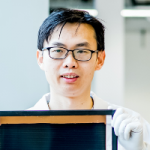PEROVSKITE MODULES
Scaling up processes for glass based single junction modules
Perovskite is a very promising thin-film solar technology. The efficiency has proven to be high and can potentially even higher. But these records are set on miniature lab cell, selected from a batch. How can we scale up this technology from spin-coated mini cells to large solar modules? Valerio Zardetto (TNO) and Yinghuan Kuang (imec) will tell you the latest developments and backgrounds on this technology.
Scaling up processes for glass based single junction modules
Perovskite is a very promising thin-film solar technology. The efficiency has proven to be high and can potentially even higher. But these records are set on miniature lab cell, selected from a batch. How can we scale up this technology from spin-coated mini cells to large solar modules? Valerio Zardetto (TNO) and Yinghuan Kuang (imec) will tell you the latest developments and backgrounds on this technology.
2 November 2020
09:00 CET
Brussels
16:00 CST
Shanghai
17:00 JST
Tokyo
Registration Free
Yinghuan Kuang

Yinghuan Kuang received his PhD in applied physics in 2014 from the Utrecht University, The Netherlands. During his PhD he mainly worked on thin-film silicon solar cells under the supervision of Prof. Dr. Ruud Schropp. From July 2014 till January 2018 he worked as a postdoctoral researcher in the Plasma & Materials Processing (PMP) group, the Eindhoven University of Technology in the Netherlands. There he was mainly involved in atomic layer deposition of thin films for perovskite solar cell and silicon heterojunction solar cell applications.
These thin-film materials include defect passivation layer of Al2O3, electron and hole selective transport layers of e.g. SnO2 and NiO, and transparent conducting oxides of e.g. In2O3:H. Since 2018 he is a senior researcher & project leader in the Thin Film PV group at Imec. He is currently mainly working on upscaling of perovskite-based photovoltaic modules with stability towards commercialization. He also coordinates the development of perovskite-silicon and perovskite-CIGS tandem photovoltaics.
Valerio Zardetto

Valerio Zardetto received his Ph.D. in Electronic Engineering from the University of Rome “Tor Vergata” in 2013. After his doctorate, he joined the Plasma and Materials Processing group at the Applied Physics department of the Eindhoven University of Technology, working on the field of atomic layer deposition (ALD) of thin inorganic films for photovoltaic devices.
He is currently a researcher scientist at Nederlandse Organisatie voor toegepast-natuurwetenschappelijk onderzoek (TNO) in the Netherlands. His research focuses on the development of thin film solar cell technologies, including the perovskite and CIGS solar cells and the development of thin film deposition techniques such as ALD.
Other webinars
-
Scaling up processes for perovskite modules
The prospects of perovskite based solar are high. But the records set on miniature lab cell, must be translated to larger modules. How can we scale up this technology to industrial processes? Valerio Zardetto (TNO) and Yinghuan Kuang (imec) will tell you the l...
-
Roll-to-roll processing of single junction modules
To come to a sustainable energy production, we need large amounts of solar cells. For perovskite solution based printing techniques are available, so the future perovskite solar modules are printed on flexible carriers. Roll-to-roll processes are researched by...
-
Hybrid tandems with perovskite
One of the unique features of perovskite based solar cells is their translucency. Only a part of the spectrum is absorbed, leaving the module is transparent for other colours. This means another solar modules can convert the' left-over' to electrical energy. T...
-
Multi junction cells of perovskite
What is possible if you take this tandem concept even further? Can you fine tune the absorption wave length? What happens if you stack three, four or even more perovskite based solar cells on top of each other?...








